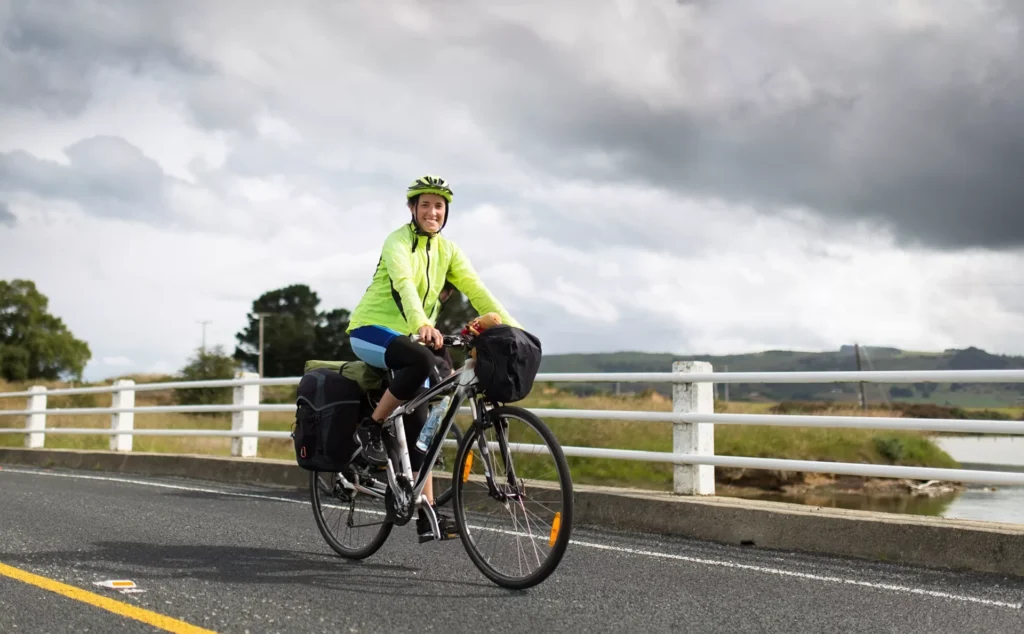Cycling Tour Safety Protocols for 2025 Travel
Cycling tours have surged in popularity as a sustainable and immersive way to explore the world, with the global cycling tourism market projected to reach $262.7 billion in 2025. For remote workers, families, and adventure enthusiasts, these tours offer a unique blend of physical activity, cultural exploration, and eco-friendly travel. However, safety remains paramount, especially as urban and rural cycling environments evolve with new regulations and infrastructure. Cycling tour safety protocols for 2025 travel are critical to ensuring a secure and enjoyable experience, addressing risks like traffic, weather, and health concerns. This article outlines the latest safety protocols, best practices, and tips for cyclists embarking on tours in 2025, drawing on global trends and expert recommendations.
Why Safety Protocols Matter for Cycling Tours
Cycling tours expose riders to diverse environments, from bustling city streets to remote mountain trails. Without proper precautions, risks such as accidents, theft, or health issues can disrupt the adventure. Cycling tour safety protocols for 2025 travel are designed to mitigate these risks, incorporating updated regulations, advanced technology, and lessons from post-COVID travel. These protocols ensure riders can focus on the journey while tour operators maintain high standards of safety and responsibility.
The Importance of Safety in Cycling Tourism
Safety protocols protect cyclists from common hazards, including collisions with vehicles, poor road conditions, and fatigue-related injuries. They also address emerging concerns, such as e-bike battery safety and health precautions in a post-pandemic world. By adhering to cycling tour safety protocols for 2025 travel, tour operators and cyclists can reduce accidents, enhance visibility, and promote sustainable travel practices.

Evolving Safety Standards in 2025
The cycling industry has seen significant safety advancements in 2025, driven by organizations like the Union Cycliste Internationale (UCI) and regional governments. New regulations, such as extended safety zones in races like the Tour de France, reflect a broader commitment to cyclist safety. Additionally, cities worldwide are expanding bike lanes and implementing traffic calming measures, making cycling tour safety protocols for 2025 travel more robust than ever.
Key Cycling Tour Safety Protocols for 2025
To ensure a safe cycling tour, operators and participants must follow comprehensive protocols covering equipment, road safety, health, and emergency preparedness. Below are the top cycling tour safety protocols for 2025 travel, tailored to meet modern challenges.
1. Mandatory Safety Gear and Equipment
Helmets and Protective Gear
Helmets are a cornerstone of cycling safety, mandatory in many regions for all cyclists in 2025. For example, Spain’s DGT regulations require helmets on all roads, with fines up to €200 for non-compliance. Tour operators like Intrepid Travel emphasize helmets for all participants, especially children under 12, as seen in France. Padded shorts, gloves, and knee pads further reduce injury risk during falls.
Visibility Equipment
Visibility is critical, especially in low-light or urban settings. Cycling tour safety protocols for 2025 travel mandate reflective vests and certified lights visible from 150 meters in low-visibility conditions. Rear red lights and spoke reflectors enhance detection by vehicles. Eltin recommends keeping lights on even during the day to improve visibility.
Bike Maintenance and E-Bike Standards
Regular bike maintenance is essential. Tour operators like G Adventures ensure bikes are serviced regularly, with leaders trained to fix flat tires or broken chains. For e-bikes, batteries must meet UL 2849 or UL 2271 safety certifications to prevent fire risks. Cyclists should verify battery compatibility and condition before tours, especially for longer commutes.
2. Road Safety and Traffic Regulations
Adhering to Local Laws
Cyclists must follow local traffic laws, which vary by country. In Germany, cyclists can ride contraflow on certain one-way streets, while Japan imposes penalties for smartphone use while cycling. Researching destination-specific rules via government websites or cycling advocacy groups is crucial. For example, France requires cyclists to use hand signals and stay visible, with dedicated bike lanes in urban areas.
Safe Riding Practices
Cycling tour safety protocols for 2025 travel emphasize defensive riding to avoid reckless drivers. Cyclists should assume vehicles may not see them, use bike lanes where available, and avoid heavy traffic routes. Tour operators like Backroads plan routes with cycling-friendly apps to minimize risks. In urban areas, cyclists must ride in the center of the lane, with vehicles maintaining a 5-meter distance, as per Spain’s 2025 DGT rules.
Overtaking Regulations
Improper overtaking by vehicles is a leading cause of cycling accidents. In 2025, regulations require drivers to maintain a 1.5-meter lateral distance when overtaking cyclists and reduce speed by 20 km/h below the limit on interurban roads. Failure to comply can result in fines and license point deductions. Tour support vehicles often act as back markers to ensure safe overtaking and prevent stragglers.
3. Health and Hygiene Protocols
Post-COVID Health Measures
While the global emergency status for COVID-19 ended in 2023, health precautions remain integral to cycling tour safety protocols for 2025 travel. Operators like Ride and Seek recommend regular hand washing, disinfecting bikes, and maintaining social distancing where possible. Cyclists testing positive during a tour should isolate and follow local guidelines, with tour operators providing support like alternative transport or medical referrals.
Preventing Gastrointestinal Issues
Long-distance cycling can suppress the immune system, increasing susceptibility to gastrointestinal illnesses. TDA Global Cycling emphasizes hand hygiene and hydration with oral rehydration salts to prevent and treat diarrhea. Cyclists should choose clean, reputable eateries and carry dry goods like pasta for remote routes to ensure safe nutrition.
Physical Preparedness
Cyclists must match their fitness level to the tour’s physical demands. G Adventures assigns physical grading designations to tours, indicating distance, elevation, and terrain difficulty. Consulting a doctor for a “fit for travel” assessment is recommended, especially for high-altitude or strenuous tours.
4. Emergency Preparedness and Support
Support Vehicles and Guides
Most cycling tours in 2025 include support vehicles to assist with injuries, hazardous weather, or mechanical issues. Intrepid Travel’s trips feature vehicles as back markers, ensuring no cyclist is left behind. Guides are trained in basic first aid and cycling health, with operators like Discover France offering support vans with professional credentials for immediate assistance.
Emergency Contacts and Insurance
Cyclists should carry a charged phone with emergency numbers, such as 112 in Europe, and travel insurance details. Comprehensive travel insurance is mandatory for many tours, covering injuries and bike damage. World Nomads offers plans for over 150 activities, including cycling, but may require upgrades for independent tours or high-altitude rides.
Incident Reporting and Safety Databases
The UCI’s SafeR initiative, tested in 2024, tracks incidents via a Race Incidents Database, logging 341 crashes in major races to identify high-risk areas like sprints or descents. Tour operators adopt similar practices, reviewing incidents to improve route planning and safety measures, ensuring safer experiences in 2025.
5. Group Dynamics and Tour Structure
Small Group Sizes
Small groups enhance safety by reducing congestion and allowing closer supervision. Intrepid Travel limits groups to 16, averaging 10, fostering camaraderie and easier management. Smaller groups also minimize exposure to health risks and enable tailored pacing for varying skill levels.
Leader Training and Route Planning
Guides are cycling enthusiasts trained in safety and first aid, having ridden every route in advance. They lead from the front, control pacing, and use support vehicles to monitor the group. Backroads offers flexible route options, from leisurely to avid, ensuring safety for all fitness levels.
Tips for Cyclists Preparing for a Safe 2025 Tour
Research and Planning
-
Check Tour Details: Confirm the tour’s difficulty, terrain, and safety measures. Operators like TourRadar provide briefings on bike safety and route specifics.
-
Review Local Laws: Use resources like PezCycling News to understand destination-specific regulations, such as e-bike rules or helmet mandates.
-
Plan Routes: Use GPS apps or cycling-friendly maps to avoid high-traffic areas. Mark rest stops and ensure offline navigation tools are available.
Packing Essentials
-
Safety Gear: Pack a helmet, reflective vest, lights, and repair kit. Lightweight, breathable clothing and padded shorts enhance comfort.
-
Documents: Carry ID, insurance details, and emergency contacts in a waterproof pouch. Digital copies are also recommended.
-
Health Supplies: Include hand sanitizer, oral rehydration salts, and a first-aid kit for minor injuries or illnesses.
During the Tour
-
Stay Visible: Wear bright or reflective clothing, even during the day, and use lights in low visibility.
-
Follow Guide Instructions: Adhere to the leader’s pacing and route guidance to stay safe and avoid getting lost.
-
Maintain Hygiene: Wash hands frequently, disinfect gear, and avoid sharing bikes to minimize health risks.
Emergency Preparedness
-
Know Emergency Contacts: Save local emergency numbers and tour operator contacts. In Europe, 112 connects to medical or police services.
-
Stay Insured: Ensure your travel insurance covers cycling activities, especially for independent or high-risk tours.
-
Report Incidents: Inform guides of any accidents or near-misses to improve future safety measures.
Conclusion
Cycling tour safety protocols for 2025 travel are essential for ensuring a secure, enjoyable, and sustainable adventure. By prioritizing mandatory gear, adhering to local traffic laws, maintaining health and hygiene, and leveraging support from trained guides and vehicles, cyclists can explore with confidence. Operators like Intrepid Travel and Backroads set the standard with rigorous safety assessments and small group sizes, while global regulations enhance infrastructure and visibility. Whether pedaling through France’s Provence or Vietnam’s Mai Chau valley, these protocols empower cyclists to embrace the open road safely. For more insights, explore Intrepid Travel’s cycling safety guide and PezCycling News’ 2025 safety tips. Start planning your safe cycling adventure today and ride into 2025 with peace of mind.



